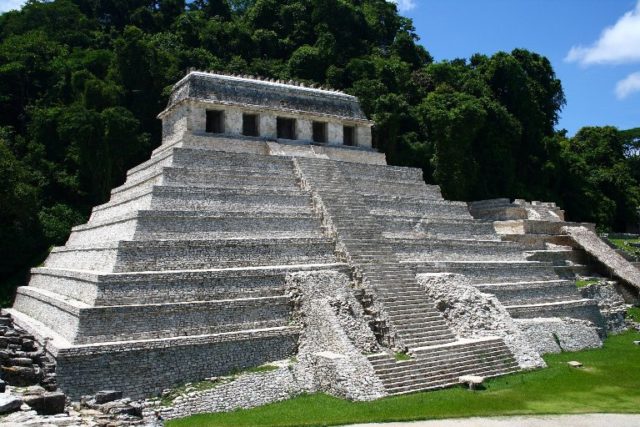A water tunnel found underneath an ancient Mayan pyramid may have been used in a ceremony to transport the souls of the dead to the underworld.
Archaeologists unearthed a two-foot tunnel beneath the Temple of Inscriptions, which houses the tomb of ancient Mayan ruler K’inich Janaab’ Pakal. Experts speculate that the water tunnel was constructed for a mysterious ritual to carry the dead king’s soul to the underworld.
The Temple of Inscriptions was built to be a luxurious monument. It was a cornerstone of the ancient city of Palenque, acting as the burial ground of one the civilization’s greatest rulers. The Temple was unearthed two centuries ago, but many of its secrets have yet to be uncovered.

Source: By Jan Harenburg – own photography, CC BY 3.0,
One of those discoveries included a well-irrigated underground tunnel deep below the tomb. Archaeologists have discovered that the underground water tunnel crosses the tomb of the ancient ruler Pakal, cutting through the middle of the temple and the heart of the structure. The water was sourced from an underground spring which lay beneath the ancient city. This was a fitting waterway to carry the spirit of Pakal to the underworld beyond.

It has been speculated that the wondrous pyramid was built between 683 and 702 AD. The tomb was purposely constructed above the spring to allow safe passage in the afterlife.
K’inich Janaab Pakal was the proud ruler of the Mayan city-state of Palenque for almost 70 years. This brilliant ruler died at age 80 in the year 683AD. It is believed that the great king ascended to the throne at the age of 12. He was known to have expanded Palenque’s influence across Western Maya during his reign. Pakal is thought to have presided over a golden age which produced his civilization’s most elegant and influential architecture.
The Temple of Inscriptions was stumbled across 200 years ago and was quickly speculated to have been the burial grounds of the great ruler Pakal. But for over a century the tomb remained elusive as archaeologists continued to come up empty-handed. Finally, the mystery of Pakal’s tomb was cracked in the 1950s. Inside the grave, there was a lavishly-decorated sarcophagus featuring a depiction of the ancient ruler. Archaeologists also found the monarch’s skeleton fully intact. Pakal’s elaborate death mask was crafted from jade, with eyes made from mother of pearl and obsidian.

At the entrance of the famous crypt, there are the statues of five protectors, believed to be advisers sacrificed to guide Pakal to the underworld. The addition of an underground tunnel provides historians with deeper insights into the religious beliefs and burial rituals of the ancient Mayans.
In addition to Pakal’s crypt, the temple houses many priceless treasures, including elegant carvings adorning the chamber’s five doors.
This new finding further reinforces the theory that water played a greater role in Mayan belief systems than had been previously believed.
